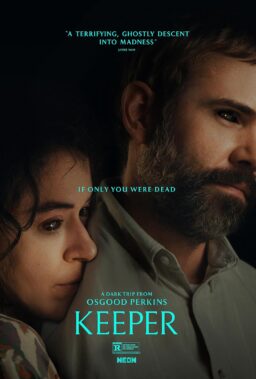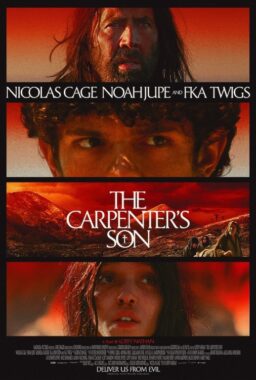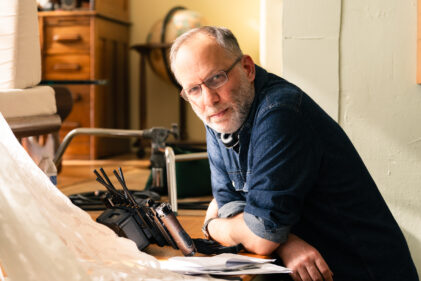Although there is no record in the Bible regarding the goings-on in the life of Jesus Christ between the ages of 12 and 30, many over the years have taken it upon themselves to speculate what he might have been up to during that time. Perhaps the most entertaining take on this idea was “Jesus the Missing Years,” the daffily surreal concluding track from the late and truly great John Prine’s 1991 album The Missing Years that has Jesus, among other things, marrying an Irish lass, seeing “Rebel Without a Cause” on his 13th birthday, inventing Santa Claus and being the opening act at a concert headlined by George Jones. Like the best Prine songs, it is written with such wit, insight and vivid detail that you can close your eyes while listening to it and practically see it unfolding in front of you like a movie over the course of the six minutes that it runs. That brief mental film, by the way, is infinitely more compelling than anything to be found in “The Carpenter’s Son,” which takes the same basic speculative premise and reforms it as a generally tedious and occasionally goofy horror/coming-of-age saga featuring a performance from Nicolas Cage that will inspire more shrugs from viewers than anything else.
It should be noted that Cage himself is not playing Christ here, a notion that might have dumbfounded viewers of all faiths and/or creeds. As the film opens, Cage’s Joseph is having hallucinatory visions in a manger while his wife Mary (FKA twigs) is giving birth to the baby Jesus. After managing to avoid Roman soldiers who are taking newborn males and tossing them onto a bonfire, they disappear into the darkness, and, when the story picks up fifteen years later, the three are taking up residence in a remote Egyptian village. Although the now-teenaged Jesus (Noah Jupe) is seen dealing with a number of ordinary concerns for a person of his age, ranging from chafing under the control of his overly strict father to sneaking peeks at pretty neighbor Lilith (Souhelia Yacoub) while she is undressed, he is also beginning to suspect that there is something about him that his parents are not telling him, a notion that is further fueled by his encounters with a mysterious girl (Isla Johnston) who is always hovering on the outskirts of everything.
As Jesus begins to discover that he has some unusual abilities, Joseph reacts by bearing down on him even harder while Mary acts in a more loving manner, even as neither give up any secrets. Before long, however, a number of increasingly horrifying and inexplicable events begin to befall the locals, eventually turning them against the family. Eventually, Jesus is informed of who he really is and, perhaps not surprisingly, he does not take the news particularly well, forcing him to combat the forces seemingly out to get him while trying to figure out the path he wants to take. This inevitably leads to a confrontation with the mysterious girl, who is perhaps not the friend she initially seems to be and who may in fact be … well, you can probably guess the name, though perhaps not the singular manner in which it is pronounced.
“The Carpenter’s Son” takes the well-known origin story of a hero beloved by millions around the world and reconfigure it in a more overtly horrific manner. Because of this, a number of people have already denounced the film unseen as being blasphemous, a notion that I would disagree with, partly because I think that it is technically more of a heresy than a blasphemy (though I will defer to any actual theologians out there if I am off in this regard) and partly because doing so suggests that the movie has a kind of power that it simply doesn’t possess. (The closest it gets to ever becoming legitimately transgressive are in a few scenes between Jesus and Mary that vaguely suggest a certain creepy twist in the nature of their relationship at times.)
While the premise has some undeniable potential, it has been executed by writer-director Lotfy Nathan in a manner that is neither particularly frightening nor spiritually enlightening. The conflict between Jesus and Joseph is depicted in fairly banal terms while Jesus’s inner conflict lacks the combination of terror and gradual sense of enlightenment necessary to pull such a concept off. As for the horror elements, it always feels as if Nathan is holding back a bit, as though afraid to fully take the plunge. (That said, although hardly an over-the-top gore fest on the level of “The Passion of the Christ” by any means, there is still enough bloodshed to ensure the film’s “R” rating.)
Other than the pseudo-wild basic concept, the main draw for “The Carpenter’s Son” will be the notion of Cage dipping his toe into the sub-genre of overtly religious-themed horror for what I think is the first time, depending on what you consider “Left Behind” to be (though I will defer to any actual Cageologians out there if I am off in this regard). Outside of a couple of borderline daft line readings and screaming harangues, his turn is largely forgettable, as if he realized early on that this was not going to go down as one of his more notable projects and just decided to blow through it as quickly as possible. Meanwhile, FKA twigs does little other than stand around and look vaguely concerned at the craziness surrounding her while Jupe plays teen Christ as if he was a refugee from “Stranger Things” for the most part—plenty of teen angst and reacting to special effect—but there is never a time when you feel even remotely emotionally involved in his crisis or its resolution.
Sometimes after watching a movie that just doesn’t work, I idly speculate on whether there were other filmmakers that might have actually made something of the basic elements or if it was just a bad idea from the start. After watching “The Carpenter’s Son,” I immediately became consumed with the notion that if Ken Russell were still alive and making movies, he might well have made something of it. He was a guy who was not afraid of projects that took wild creative swings, combined strange narratives, eye-popping visuals, and heedless energy and properly utilized the talents of actors with a propensity for gnawing on the scenery. Even if he couldn’t ultimately pull it off with the elements at hand, he would have known how to deploy them in a more interesting manner than is on display here. Besides, if he was going to set out to make a movie that was actually blasphemous, I can guarantee that by the time it was all over, you would be well and thoroughly blasphemed.




















